या देवी सर्वभूतेषु शक्ति-रूपेण संस्थिता। नमस्तस्यै नमस्तस्यै नमस्तस्यै नमो नमः॥
Maa Durga is omnipresent one. She is the personification of the Universal Mother. She is the embodiment of power, peace and intelligence in all beings. I worship her with all devotion so that she blesses me with happiness and prosperity.
What is Navratri Festival (Meaning)? Navratri Importance
.jpg)
“Nav” means 9 & “Ratri” means nights, thus Navratri is a vibrant and auspicious Hindu festival celebrated over 9 nights to honor the divine feminine, or Shakti. This festival is dedicated to the worship of Divine Feminine Deity “Shakti” also known as Durga Devi who took birth to eradicate ignorance & evil and restore harmony, peace & balance to the universe. Different forms which represent different aspects of Durga Devi are worshipped over the course of 9 Days and various rituals are performed to honor the Divine Feminine force which created this entire universe.
Navratri Dates & Timings (Muhurat & Tithi)
Chaitra Navratri
2026 will be celebrated from 19 March 2026 – 27 March, 2026
Ashadha Gupt Navratri
2026 will be celebrated from July 15 - July 23, 2026
Sharada Navratri
2026 will be celebrated from October 11, 2026 - October 19, 2026
Magha Gupt Navratri
2026 will be celebrated from January 19 - January 27, 2026
Navrati (Sharad) 2026: Dates, Tithi & Meaning
|
Date & Day |
Puja |
|---|---|
|
11th October 2026, Sunday |
Ghatasthapana, Shailputri Puja
Navratri color of the day – Orange |
|
12th October 2026, Monday |
Chandra Darshana, Brahmacharini Puja
Navratri color of the day – White |
|
13th October 2026, Tuesday |
Sindoor Tritiya, Chandraghanta Puja
Navratri color of the day – Red |
|
14th October 2026, Wednesday |
Kushmanda Puja, Vinayaka Chaturthi
Navratri color of the day – Royal Blue |
|
15th October 2026, Thursday |
Upang Lalita Vrat, Skandamata Puja
Navratri color of the day – Yellow |
|
16th October 2026, Friday |
Saraswati Avahan, Katyayani Puja
Navratri color of the day – Green |
|
17th October 2026, Saturday |
Saraswati Puja, Kalaratri Puja
Navratri color of the day – Grey |
|
18th October 2026, Sunday |
—
Navratri color of the day – Purple |
|
19th October 2026, Monday |
Durga Ashtami, Mahagauri Puja, Sandhi Puja, Maha Navami
Sandhi Puja: Begins - 10:27 AM |
|
20th October 2026, Tuesday |
Ayudha Puja, Navami Homa, Navratri Parana, Durga Visarjan, Vijayadashami |
Ashwina Ghatasthapana on
Sunday, October 11, 2026
Ghatasthapana Muhurat - 06:31 AM to 10:27 AM
Duration - 03 Hours 56 Mins
Ghatasthapana Abhijit Muhurat - 12:01 PM to 12:49 PM
Duration - 00 Hours 47 Mins
Ghatasthapana Muhurta falls on Pratipada Tithi
Ghatasthapana Muhurta falls during prohibited Chitra Nakshatra
Ghatasthapana Muhurta falls during prohibited Vaidhriti Yoga
Pratipada Tithi Begins - 09:19 PM on Oct 10, 2026
Pratipada Tithi Ends - 09:30 PM on Oct 11, 2026
Chitra Nakshatra Begins - 09:42 PM on Oct 10, 2026
Chitra Nakshatra Ends - 10:32 PM on Oct 11, 2026
Vaidhriti Yoga Begins - 10:02 PM on Oct 10, 2026
Vaidhriti Yoga Ends - 09:05 PM on Oct 11, 2026
Legends of Navratri Festival and its Spiritual Significance.
Navratri celebrates the divine triumph of Maa Durga over powerful demons, symbolizing the eradication of negativity from the universe and the restoration of righteousness. Each demon slain by the Goddess represents a specific vice, and the legends of these battles highlight her courage, strength, and divine grace in removing obstacles from the lives of her devotees.

The first demons to be slain by Maa Durga were Madhu and Kaitabha. Madhu symbolizes attachment to pleasure and enjoyment, while Kaitabha represents attachment to suffering and self-mortification in the name of devotion. These opposing forces often keep one bound to worldly existence. Before beginning the spiritual path, one must overcome both these attachments to experience true liberation. By killing Madhu and Kaitabha, Maa Durga symbolizes the need to eradicate such attachments to set the foundation for genuine spiritual growth.
Next came Chanda and Munda, who represent the forces of Pravritti (worldly engagement) and Nivritti (withdrawal from the world). The Shakta path, followed in Tantra, teaches balance—remaining in the world but not being overwhelmed by it. As Lord Krishna says in the Bhagavad Gita, 'Be like a lotus that grows in the mud but remains untouched by it.' Maa Durga's victory over Chand and Mund conveys the importance of neutrality, neither being excessively attached nor detached from worldly life.
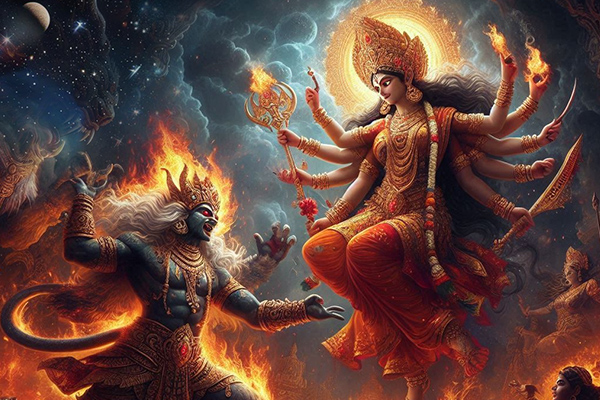
Following this, Maa Durga faced Raktabeej, whose blood had the power to give birth to new demons every time it fell to the ground. He represents desires and thoughts that cannot be simply killed or suppressed; trying to repress them often leads to even more powerful manifestations. When Maa Kali, an aspect of Maa Durga, drank Raktabeej’s blood, she purified his energy and freed the world from his chaotic influence. This act symbolizes allowing the divine feminine energy, Maa Shakti, to cleanse and purify our thoughts, ultimately leading to the state of Samadhi (thoughtless meditation).
The most challenging demons faced by Maa Durga were Shumbh and Nishumbh. These demons represent Asmita, or the feeling of 'I am.' Shumbh symbolizes the pure ego— “I am”—even in the form of noble realizations like 'I am pure consciousness' or 'I am Shiva.' Nishumbh, on the other hand, symbolizes the attachment or sense of ownership associated with this identity (Mamattva). Most schools of Vedanta end with the realization of 'I am pure consciousness,' but Tantra goes further, suggesting even this sense of self must be transcended. Maa Durga’s conquest of Shumbh and Nishumbh represents the final annihilation of ego and attachment, leading to true liberation and unity with the Divine.
Finally, Maa Durga battled Mahishasura, the buffalo demon, whose form symbolizes body-based ego and the tamasic (dark and ignorant) arrogance that disregards everything in its way, like a charging bull. Mahishasura had obtained a boon from Lord Brahma that he would not be killed by any god, human, or demon. Misusing this boon, Mahishasura took control over heaven and earth, spreading chaos. To end his reign of terror, the divine trinity—Brahma, Vishnu, and Shiva—combined their energies to create Maa Durga. With divine weapons gifted by the gods—such as Shiva’s trident, Vishnu’s Sudarshan Chakra, and Indra’s Vajra—Maa Durga fought Mahishasura for nine days and nights, eventually slaying him on the tenth day. This final victory symbolizes the need to overcome ego and blind arrogance to progress on the spiritual path. It is why she is called Mahishasura Mardini, the slayer of the buffalo demon, and this triumph is celebrated as Vijayadashami, the victory of good over evil.
Maa Durga is also known as Adi Shakti, Jagadamba, and Mahakali. Her three eyes represent fire, sun, and moon, symbolizing illumination and awareness. She received her name, Durga, after killing the demon Durgasur, who represented insurmountable challenges. The name also means 'undefeated' and signifies the energy that can overcome all difficulties. Maa Durga rides a lion, symbolizing her strength and bravery, while her trident represents mastery over the three gunas—Tamas, Rajas, and Sattva.
In another legend related to Navratri, Shri Ram worshipped the nine forms of Maa Durga for nine consecutive days, seeking her blessings to defeat the demon, Ravana. On the tenth day, with Durga’s divine grace, Ram successfully defeated Ravana, a victory commemorated annually as Dussehra.
Maa Durga represents the supreme power, embodying the divine feminine energy that vanquishes all negativity and restores balance in the universe. The demons she defeated are not just mythical beings but also represent inner vices, attachments, and blockages that one must overcome to achieve true liberation and harmony.
Types of Navratri
Magha Navratri

The relatively lesser-known Magha Navratri holds immense spiritual significance. It is celebrated in Magha, which typically falls in January or February.
Magha Navaratri is a Gupt Navratri and is dedicated to the esoteric and mystical practices of worshipping the Divine Feminine energy. Engaging in spiritual practices such as fasting and meditating on the Divine Mother’s glory during the period of Magha Navaratri is known to yield great spiritual and material benefits. It brings divine blessings, protection and spiritual growth. Performing spiritual practices and performing ancient sadhanas during this period enhances their potency and efficacy.
Magha Navratri provides an opportunity for devotees to deepen their spiritual connection, seek blessings, and immerse themselves in the immensely powerful embrace of the Divine energy.
Read More: Magh Gupt Navratri 2025
Chaitra Navratri
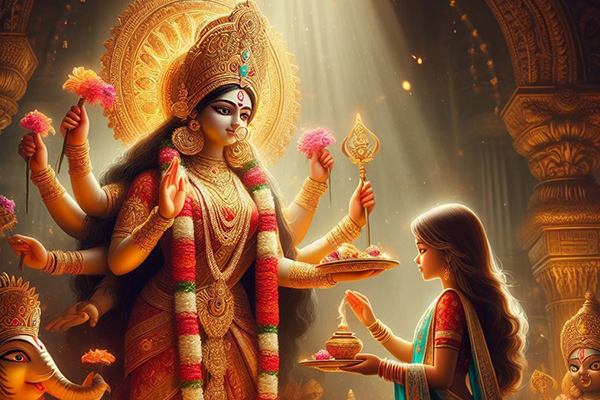
Chaitra Navratri is celebrated in the spring season, usually in March or April. As per the Hindu calendar, Chaitra is the first month of the year and the Chaitra Navratri presents an incredible opportunity to begin the year by turning inwards and connecting with the Divine Feminine energy.
Navratri is not only a time of celebration but also a period of introspection and spiritual growth. Devotees observe fasting, perform rituals, and engage in prayers and meditation to seek the blessings of Goddess Durga. It is believed that during Navratri, the goddess descends to the earthly realm and showers her devotees with divine grace and blessings.
Chaitra Navratri is observed with great reverence in Northern India, particularly Uttar Pradesh and Uttarakhand. During Chaitra Navratri, devotees honor and worship Goddess Durga and her various forms through fasting, recitation of sacred texts and performing ancient Sadhana.
The ninth day of Chaitra Navratri is celebrated as Ram Navami, commemorating the birth of Shri Ram. The celebration of Ram Navami is a reminder of Shri Ram’s teachings and the values he embodied, including truth, righteousness, and compassion. It serves as an occasion for individuals to introspect and strive to incorporate these virtues into their own lives. It is a time for devotees to seek blessings, find inspiration, and renew their commitment to leading a righteous life.
Read More: Chaitra Navratri 2025
Ashada Navratri

Ashada Navratri, also known as Gayatri Ashad Navratri, is a relatively lesser-known Navratri which is observed during the Ashad Shukla Paksha. It typically falls in the months of June or July.
Just like Magha Navratri, Ashada Navratri is also a Gupt Navratri. For Tantriks and Sadhaks, Gupt Navratri holds special importance. Ths navratri is also the time to worship varahi form of Devi. These nine days and nights are considered highly powerful, meritorious and beneficial to worship the sacred Divine Feminine.
During Ashada Navratri, devotees engage in various spiritual practices, including the Nav Durga Sadhana of Goddess Durga. It is believed that performing this Sadhana during the Gupt Navratri period can bestow manifold blessings upon individuals. The significance of Ashada Navratri lies in its ability to purify and rejuvenate the mind, body, and soul. It provides a conducive environment for devotees to engage in intense spiritual practices. The festival serves as an opportunity for individuals to deepen their connection with the divine and seek inner transformation.
To receive immense blessings and divine power you can worship Maa Durga in all the four Navratris.
Read More: Ashadh Gupt Navartri 2025
Sharad Navratri

Of the four Navratris, Sharad Navratri is the most widely known and celebrated one. It is also known as Maha Navratri. Sharad Navratri takes place in Ashwin during Autumn, usually in September or October.
The significance of Sharad Navratri is deeply rooted in the legends of Sanatana Dharma. Maa Durga fought against the demon Mahishasura for nine days and nine nights, ultimately emerging victorious on the tenth day, known as Vijayadashami or Dussehra. The festival of the sacred nine nights honors the Goddess Durga who symbolizes courage, power and protection. It also stands as a symbol of the triumph of good over evil.
In states such as Gujarat, Maharashtra and Rajasthan, Navratri is traditionally marked with grand-scale festivities. This celebratory spirit of Navratri is embodied by the energetic and vibrant Garba and Dandiya Raas dances. People dressed in colorful and traditional attire come together in large community spaces, adorned with elaborate decorations, to dance and celebrate throughout the night. The rhythmic music synchronized dance steps, and the enthusiasm of the participants create an atmosphere of joy, unity, and devotion.
Over the years, the spirit of Garba and Dandiya Raas has spread across India and the world. Navratri celebrations have become a cultural phenomenon, with events and performances held in various cities and countries. People of all ages and backgrounds join in the revelry, embracing the rich heritage and experiencing the joy of community celebration.
Navratri culminates on the tenth day with Vijayadashami. On this auspicious day, effigies of Ravana are burned as a symbolic representation of the victory of good over evil. This event is often accompanied by vibrant processions, cultural performances, and reenactments of the epic Ramayana, where Lord Ram’s victory over Ravana is celebrated.
Navratri is a time of renewal, joy, and devotion. It is an occasion for individuals to come together, connect with their spiritual roots, and celebrate the triumph of good over evil. The festival not only reinforces the significance of courage and righteousness but also promotes unity, cultural exchange, and the celebration of life.
Read More: Sharad Maha Navratri
Why are Magh & Ashadh Navratri known as Gupt Navratri?
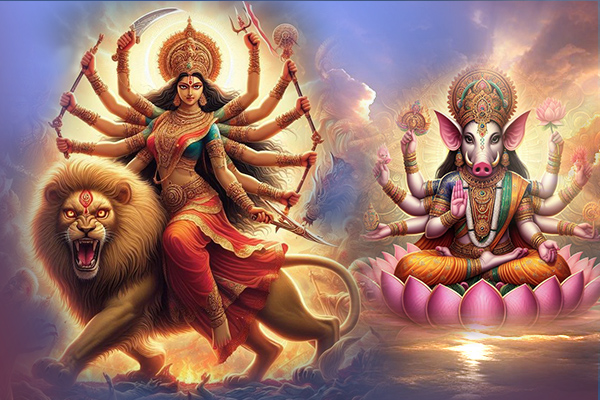
Gupt Navratri, which means 'hidden' or 'secret' Navratri, is the term given to Magh and Ashadh Navratri since they are less publicized than Chaitra and Sharad Navratri and are observed in a more intimate setting. These Navratris concentrate on deep sadhana (spiritual practice), esoteric ceremonies, and calling upon the divine forces for one's own spiritual advancement. The name Gupt connotes anything that is hidden or magical. Gupt Navratris is frequently celebrated by advanced practitioners, Sadhaks, and devotees who partake in particular forms of tantric worship and mantra sadhanas to achieve spiritual power, divine grace, and inner transformation. This is in contrast to the public celebrations and widespread rituals observed during Chaitra and Sharad Navratris. The fact that these Navratris are concealed further emphasizes the intense inward attention that is placed during these times on self-realization, purification, and connection to the Divine Mother.
What to do on Navratri?
During Sharad Navratri, various rituals are performed to honor Durga & her various forms, some of them have been listed below
Worship of Durga & Her Forms
During Navratri, devotees worship the different forms of Goddess Durga. Usually on Chaitra & Sharad Navratri people worship the 9 forms of Durga aka Navdurga & on Gupt Navratri of Ashadh & Magh people worship 10 Tantric Forms of Durga aka the Dus Mahavidya, each representing a unique aspect of the divine feminine energy.
9 Devis Of Navratri | 9 Days Of Navratri Devi Names
Day 1
Pratipada, Maa Shailputri
Mantra
ॐ ऐं ह्रीं क्लीं चामुण्डायै विच्चे ॐ शैलपुत्री देव्यै नमः।
Date
11th October 2026, Sunday
Shailaputri, the daughter of the mountains symbolizing strength.
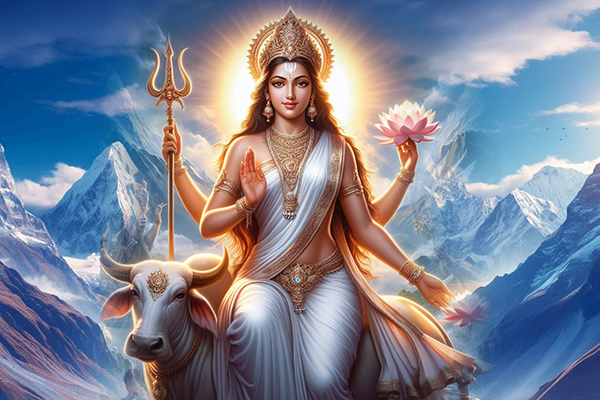
Day 2
Dwitiya, Maa Brahmacharini
Mantra
ॐ ऐं ह्रीं क्लीं चामुण्डायै विच्चे ॐ ब्रह्मचारिण्यै नमः।
Date
12th October 2026, Monday
Brahmacharini, the ascetic representing devotion.
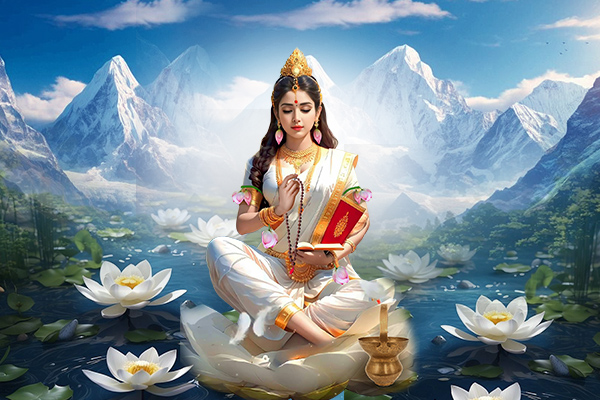
Day 3
Tritiya, Maa Chandraghanta
Mantra
ॐ ऐं ह्रीं क्लीं चामुण्डायै विच्चे ॐ चन्द्रघण्टायै नमः।
Date
13th October 2026, Tuesday
Chandraghanta, the courageous goddess with a crescent moon.
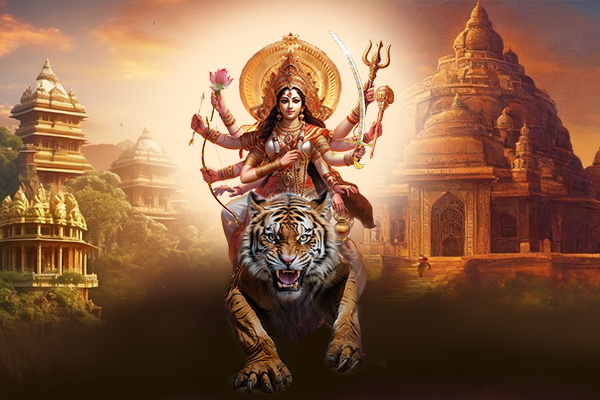
Day 4
Chaturthi, Maa Kushmanda
Mantra
ॐ ऐं ह्रीं क्लीं चामुण्डायै विच्चे ॐ कूष्माण्डायै नमः।
Date
14th October 2026, Wednesday
Kushmanda, the creator of the universe, bringing positivity.

Day 5
Panchami, Maa Skandamata
Mantra
ॐ ऐं ह्रीं क्लीं चामुण्डायै विच्चे ॐ स्कन्दमातायै नमः।
Date
15th October 2026, Thursday
Skandamata, the nurturing mother of Kartikeya.
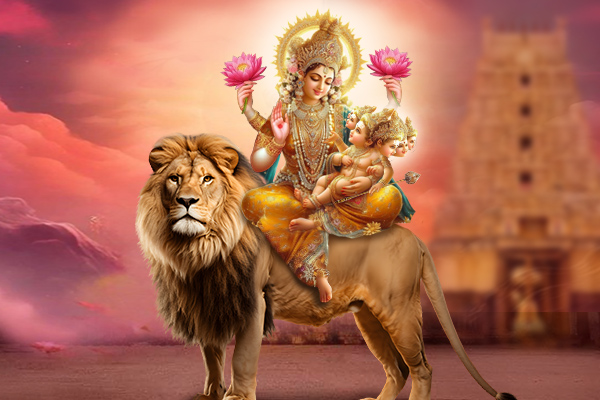
Day 6
Shashti, Maa Katyayani
Mantra
ॐ ऐं ह्रीं क्लीं चामुण्डायै विच्चे ॐ कात्यायन्यै नमः।
Date
16th October 2026, Friday
Katyayani, the fierce form born to defeat evil.
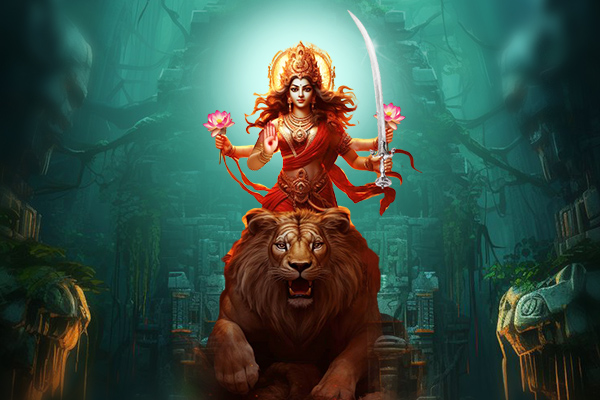
Day 7
Saptami, Maa Kalaratri
Mantra
ॐ ऐं ह्रीं क्लीं चामुण्डायै विच्चे ॐ कालरात्र्यै नमः।
Date
17th October 2026, Saturday
Kalaratri, the destroyer of negativity.
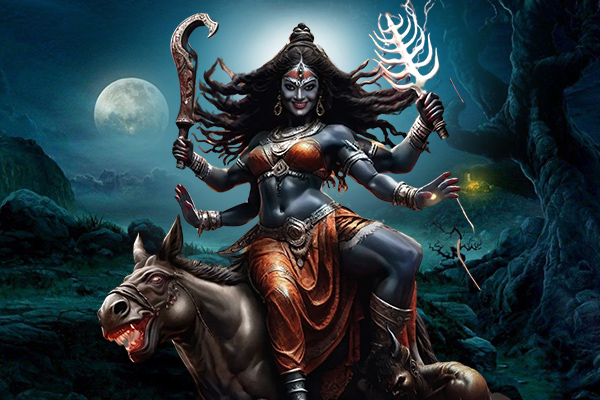
Day 8
Ashtami, Maa Mahagauri
Mantra
ॐ ऐं ह्रीं क्लीं चामुण्डायै विच्चे ॐ महागौर्यै नमः।
Date
18th October 2026, Sunday
Mahagauri, the radiant goddess symbolizing peace, and purity.
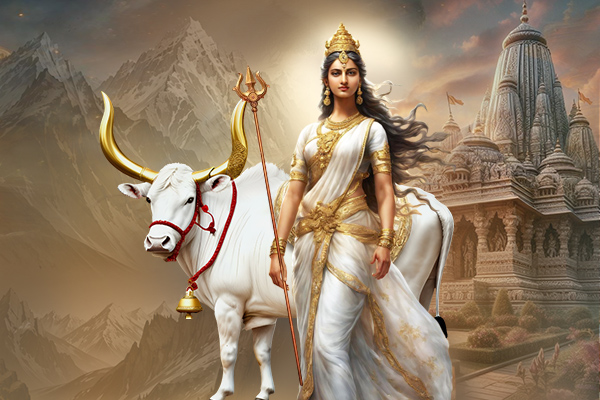
Day 9
Navami, Maa Siddhidatri
Mantra
ॐ ऐं ह्रीं क्लीं चामुण्डायै विच्चे ॐ सिद्धिदात्र्यै नमः।
Date
19th October 2026, Monday
Siddhidatri, the giver of supernatural powers.
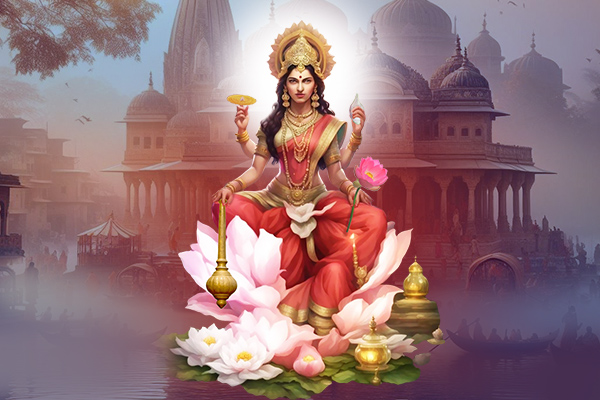
The Dus Mahavidya includes ten powerful forms of the Divine Mother:
Kali. The fierce form of Goddess Parvati, symbolizing time, transformation, and destruction of evil, bringing liberation to her devotees.
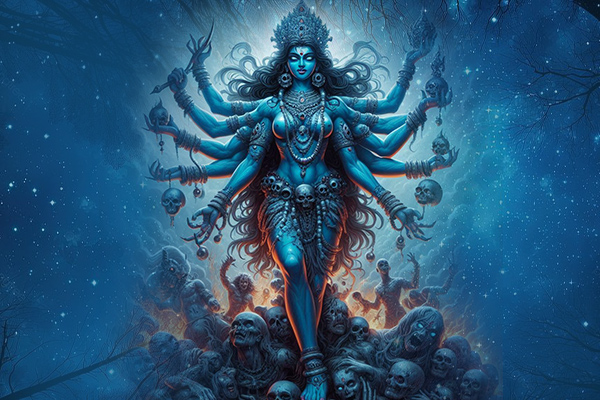
Tara. The goddess of compassion and protection, she helps overcome fear and guides devotees through difficult situations, representing the power of healing.

Tripura Sundari (Shodashi). Also known as Lalita, she is the beautiful and benevolent goddess who represents beauty, love, and ultimate consciousness.
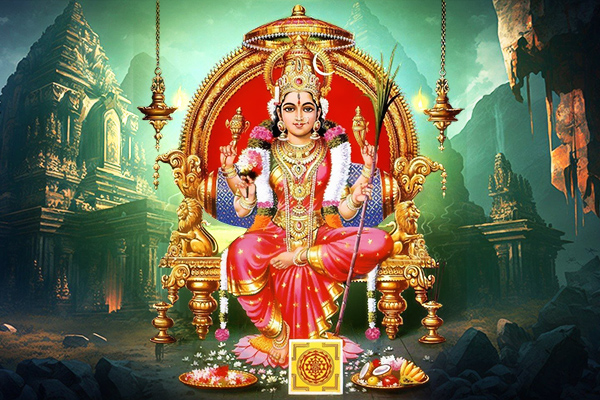
Bhuvaneshwari. The cosmic mother and queen of the universe, she embodies creation, space, and expansion, representing the infinite possibilities of existence.
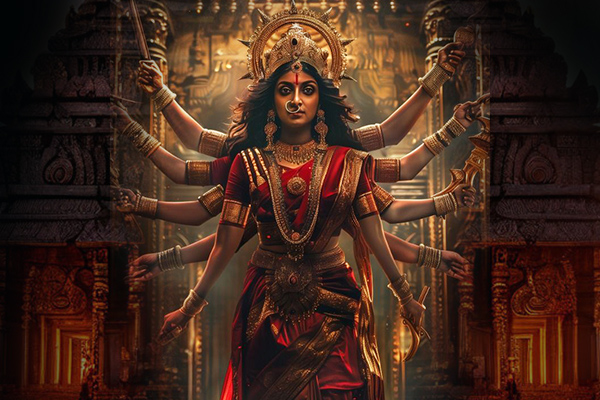
Bhairavi. The fierce goddess symbolizing the fiery power of transformation and destruction, helping to remove obstacles and negative influences from the path of the devotee.

Chinnamasta. A self-decapitated goddess who symbolizes the cycle of life, death, and rebirth, highlighting the importance of sacrifice and the release of ego.

Dhumavati. The widow goddess who represents inauspiciousness and the darker aspects of life, teaching acceptance of adversity and the impermanence of worldly existence.

Bagalamukhi. The goddess of paralyzing enemies, she helps her devotees control negative influences, bringing victory and peace in both inner and outer battles.

Matangi. The tantric form of Saraswati, she embodies inner wisdom, eloquence, and creativity, inspiring artistic expression and mastery of knowledge.

Kamala. The goddess of wealth, abundance, and beauty, Kamala is the tantric form of Laxmi, bringing material prosperity and spiritual well-being.
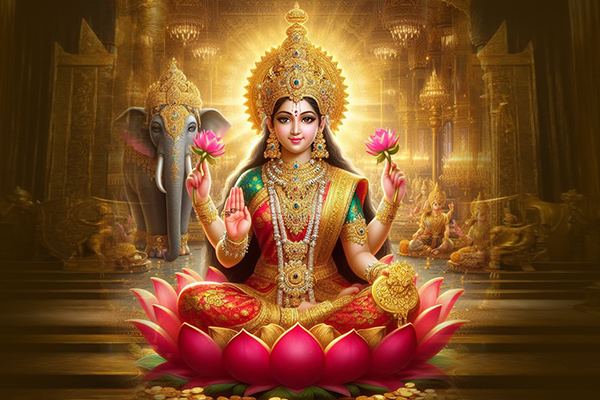
Together, these forms are worshipped for protection, wisdom, spiritual prosperity, and inner strength.
Navratri Durga Puja Vidhi (Procedure)
.jpg)
During Navratri, people do Durga Puja, which is a sixteen-step (Shodashopachara) manner of worshipping Goddess Durga.
Dhyana and Avahana, or meditation and invocation, mark the start of the puja. Goddess Durga is invited by repeating the mantra and doing the Avahan Mudra.
Then come Asana (providing a sitting), Padya Prakshalana (cleaning feet), and Arghya Samarpan (providing fragrant water).
To cleanse the god, Achamana is presented first, then Snana (bath) and Vastra (offering of garments).
Abhushana (jewelry), Chandan (sandalwood), Roli (kumkum), and Kajal are then offered.
Offerings made at Mangal Dravyarpana include rice (Akshata), Sugandhita Dravya (scent), Haridra (turmeric), and Saubhagya Sutra (thread for fortune).
Flowers (Pushpanjali) and Bilvapatra are presented first, then incense (Dhoop), food (Naivedya), fruits (Rituphala), coconut (Nikela), and betel leaves (Tambula).
Gifts, or dakshina, are given to the Goddess both before and after Kanya Pujan.
Nirajan (aarti), Pradakshina (circumambulation), and Kshamapan (asking for forgiveness for faults) mark the conclusion of the ceremony.
Reciting the Durga Saptashati, a sacred book detailing Goddess Durga's heavenly conquest and signifying the victory of good over evil, is a means for followers to get blessings.
Ghatasthapana Puja
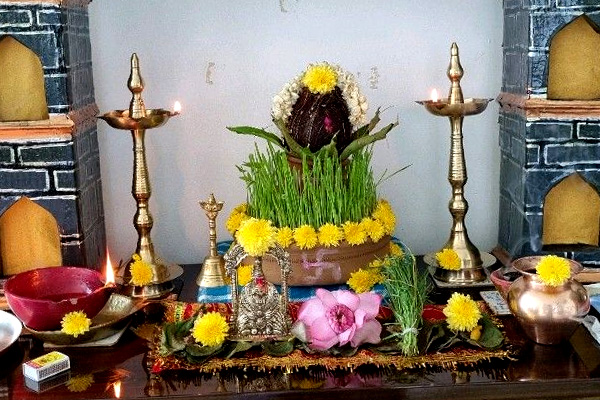
Ghatasthapana is one of the significant rituals during Navratri. It marks the beginning of 9 days festivity. Our scriptures have well defined rules and guidelines to perform Ghatasthapana during a certain period of time at the beginning of Navratri. Ghatasthapana is invocation of Goddess Shakti and doing it wrong time, as our scriptures forewarn, might bring wrath of the Goddess Shakti. Ghatasthapana is prohibited during Amavasya and nighttime.
The most auspicious or Shubh time to do Ghatasthapana is first one third of the day while Pratipada is prevailing. If due to some reasons this time is not available, then Ghatasthapana can be done during Abhijit Muhurta. It is advised to avoid Nakshatra Chitra and Vaidhriti Yoga during Ghatasthapana but those are not prohibited. The most important factor to consider is that Ghatasthapana is done before Hindu midday while Pratipada is prevailing. Invoke Goddess Durga and request Her to accept your prayers and to oblige you by residing in the Kalash for nine days.
Kanya Pujan

Traditionally Kanya Pujan is performed on Ashtami or Navami Tithi during Navratri. It is a very significant part of Navratri rituals. During Kanya Pujan 8 young girls (under the age of 11 Years) & 1 young boy (represents Batuk Bhairav Protector of all Shaktipeethas) are invited into the Native’s Home.
Kanya Puja Rituals Vidhi
Wash the feet of the young girls as a sign of respect
Apply Tilak to their foreheads
Tye a Kalawa (Raksha Sutra) on their right-hand wrists
Offer Prasad of Halwa, Puri & Chana (prepared in Sattvic Style without Onion & Garlic) to the Young Children
Give them gifts like Bangles, Notebooks, Pens, New Clothes & Money
Touch the Young Girls feet to seek the blessings of the Divine Shakti Goddess
Make the Young Children sit on a pedestal and then perform Aarti, offer Incense & Chant Durga Aarti Mantras
This is very prominent ritual in Northern Part of India. Usually, Devotees observe a fast while performing these rituals and break their fast after all the rituals are completed. This is said to please the Divine Shakti Durga Goddess.
Navratri Fasting Rules (Vrat Vidhi)
During Navratris, Hindu devotees keep fasting for nine days to please and seek blessings of Goddess Durga. There can be variation in the number of fasting days. While many observe the fasts for all nine days, there are some devotees who keep fasting in jodas (couple) - the first two or the last two days of the Navratri.
Navratri fasts have many variations too. Some people take only water during these nine days, while some eat fruits, and some people eat one meal a day. However, most people observe Falphari Upvas or Fast. Kuttu Ki Puri, Singhade Ka Halwa, Singhare Ke Pakore, Sabudana Vada and Sabudana Khichdi are some of the popular Navratri food recipes.
Here are all the fasting rules you should know and what you can eat:
Flour and Grains
Regular grains like wheat and rice are not allowed during Navratri fasting. You should eat Kuttu ka Atta (buckwheat flour) or Singhare ka Atta (water chestnut flour) or Rajgira ka Atta (amaranth flour) during Navratri fastings. Samai Ke Chawal or Samvat Ke Chwaal (barnyard millet) to replace rice in making khichdi, dhoklas or kheer. Sabudana is another staple food during Navratri that can be used in making kheer, vadas and papads.
Fruits
You can eat all types of fruits during Navratri fasting. Some devotees fast only fruits and milk for all these nine days.
Spices and Herbs
Normal table salt are not consumed during Navratris. Use an alternative rock salt or sendha namak for cooking during Navratri. In spices, you can use cumin or cumin powder, black pepper powder, green cardamom, cloves, cinnamon, ajwain, black peppercorns, dry pomegranate seeds, kokum, tamarind and nutmeg. Some people also use fresh coriander leaves, red chili powder, dry mango powder, chaat masala etc.
Vegetables
During Navratri fasting, most of the people consume vegetables like - potatoes, sweet potato, arbi, kachalu, suran or yam, lemons, raw or semi-ripe pumpkin, raw pumpkin, spinach, tomatoes, bottle gourd, cucumber, carrots etc.
Milk and dairy products
Milk and dairy products like curd, paneer or cottage cheese, white butter, ghee, malai, and preparations with milk and khoya are mostly consumed during Navratri fasting.
Food not to eat during Navratri:
All fast food, canned food, and foods prepared using onion or garlic should be avoided. Devotees who are keeping Navratri fasts should also avoid consuming legumes, lentils, rice flour, corn flour, all-purpose flour, whole wheat flour and semolina (rava). Non-vegetarian food, eggs, alcohol, smoking and aerated drinks are also a strict no-no.
Navratri Vrat Katha (Traditional Fasting Stories)
Let's look at some of the most moving stories from the Navratri Vrat Katha, which honors Goddess Durga's divine kindness and wonders for her followers:
King Sudarshan's Story

In the ancient kingdom of Ayodhya, there was a king called Sudarshan who was a true devotee of Goddess Durga. As a sign of his loyalty to the Goddess, King Sudarshan kept a strict fast during Navratri, eating only fruits and water. One year, his country was hit by a terrible drought that made the people suffer a great deal. King Sudarshan kept his fast with unshakeable faith and passionate prayer to the Goddess for her gifts, even though it was hard. Goddess Durga came to the king because he was so devoted to her. She blessed the country with lots of rain, which stopped the drought and brought wealth. This story shows how powerful unwavering faith can be and how the Goddess protects those who truly seek her kindness.
The Story of Kanchan and her Sacrifice.
Kanchan, a young girl, was known for how much she loved Goddess Durga. She did a strict fast during Navratri, going without food and water for nine days, just to honor the Goddess. Kanchan was about to break her fast on the ninth day when a hungry beggar came up to her and asked for food. When Kanchan saw how sad he looked, she didn't think twice about giving the beggar the only meal she had made for herself. The Goddess was deeply touched by her selfless sacrifice and unshakeable loyalty. Maa Durga showed up in front of Kanchan and wished her great wealth and happiness forever. This story shows how important it is to be kind and generous, and how love has benefits beyond financial wealth that make the soul greater.
The Miracle of the Cursed Merchant.
A rich trader lived in a bustling town. He was arrogant and didn't believe in the Goddess's power. During Navratri, he made fun of the people who fasted and even made fun of the traditions. He was so proud that he threw the holy Kalash (pot of prayer) into a nearby river, which was a very rude thing to do. Because the Goddess didn't like what the merchant did, she cursed him into being very poor and took away all of his wealth. Soon after, when the merchant realized what he had done wrong, he felt terrible. He fasted very strictly during Navratri and prayed severely to the Goddess to forgive him. Maa Durga dropped the curse because the merchant truly felt sorry for his actions. This made him rich again and taught him to be humble. This story is a strong lesson of how important it is to be humble, to respect God's power, and to truly turn away from your sins.
The Story of a Childless Couple
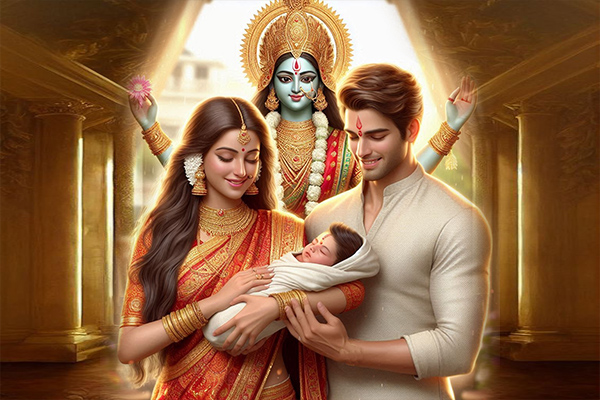
There lived a couple in a village. They sincerely wanted a child. Even though they prayed very hard and did everything they could, their wish did not come true. In the following year, during Navratri, they chose to fast for nine days in order to show their full dedication to Goddess Durga. As the days passed by, they prayed hard, hoping that Maa Durga would bless them. Their unwavering dedication moved the Goddess, and on the last day of Navratri, a miracle took place. They saw a beautiful child in front of them. It was a gift from the Goddess. They gave the child the name Kartikeya. He became a great fighter who made his family proud. This enchanting story shows what amazing gifts Maa Durga can give and how true faith and dedication can make even the greatest wishes come true.
Navratri Puja Mantra Japa
Performing Durga Mantra Japa during Navratri is a powerful approach to call upon the blessings of Goddess Durga and increase one's devotion. Chanting certain Durga mantras may assist one connect with the Goddess' divine energy, which can lead to spiritual development, power, and protection against evil energy. The most well-known mantras are:
Durga Beej Mantra
'Om Dum Durgaye Namah'
Navaran Mantra
'Om Aim Hreem Kleem Chamundaye Viche”
Throughout the nine days, repeating these mantras—ideally in a calm environment with a specific goal in mind—can help cleanse the mind, improve focus, and develop inner strength and optimism. It is advised to recite the mantra at least 108 times per day, keeping track of the chants using a mala (rosary). In addition to honoring the Goddess, this Navratri ritual promotes bravery, resiliency, and removing barriers from one's life.
Meditation

Meditation is an essential practice during Navratri to establish a strong connection with Goddess Durga's divine powers. Daily meditation facilitates the infusion of the Goddess' life-changing energy, providing inner serenity, mental clarity, and spiritual awareness. You may see Durga's divine form and invoke her blessings by sitting quietly and concentrating on her image or symbol. When meditating, using mantras like 'Om Dum Durgaye Namah' might improve the experience by bringing the mind into alignment with the vibrations of bravery and protection. It is good to focus on the many forms of Durga during Navratri, since they symbolize various facets of power, compassion, and knowledge, fostering the development of these attributes within oneself.
Durga Bhajans & Kirtans
During Navratri, singing Durga Bhajans and participating in Kirtans are beautiful ways to celebrate and immerse oneself in the divine presence of Goddess Durga. Bhajans are devotional songs that praise the various forms and qualities of Durga, while Kirtans involve group singing that creates a powerful spiritual atmosphere. These practices bring people together in devotion, filling the environment with positive vibrations and uplifting the collective spirit. Singing or listening to bhajans and kirtans during Navratri helps focus the mind on the divine, invites blessings, and allows devotees to experience a sense of joy and unity. The rhythmic chants and soulful melodies create a deep emotional connection with the Goddess, fostering devotion, strength, and inner harmony.
Navratri Donations or Daan
During Navratri, donating and performing seva for underprivileged girls and women is a highly auspicious act. Here are some meaningful ways to contribute:
Donation of Essentials: Donate clothes, food, toiletries, and educational supplies to underprivileged girls and women.
Sanitary Products: Provide sanitary products to support menstrual hygiene.
Educational Support: Sponsor the education of young girls, ensuring access to learning and opportunities.
Education for Rescued Girls: Support the education and rehabilitation of girls rescued from sex trafficking.
Support for Destitute Women or Widows: Donate to organizations that provide shelter, essential needs, or support programs for destitute women and widows.
Kanya Puja Gifts: During Kanya Puja, offer gifts like bangles, bindi, sarees, and nutritious meals to honor young girls.
Kanya Daan: Financially support the marriage of underprivileged girls, ensuring they have the means for a dignified wedding.
Vocational Training and Skill Building: Support skill-building workshops and vocational training programs to empower women.
Health Camps: Contribute to or volunteer in health camps focusing on women's wellness.
Community Kitchens: Volunteer at community kitchens serving meals to those in need.
Nutrition Support: Ensure access to proper nutrition for young girls and pregnant women.
By doing deeds of kindness and service during Navratri, people can acknowledge Goddess Durga and improve the lives of impoverished women and girls.
Importance of Durga Saptashati
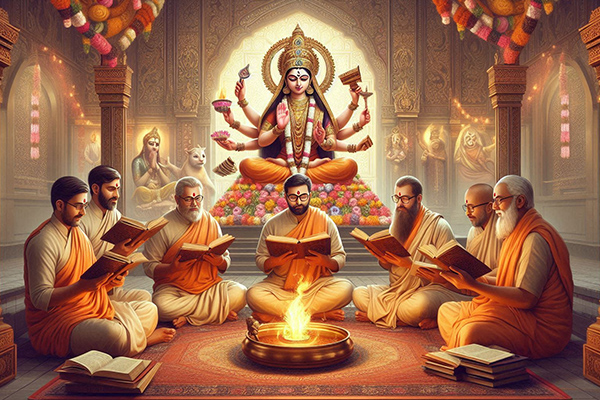
To get Maa Durga’s blessings you can recite Durga Saptashati . The Durga Saptashati (also known as Devi Mahatmya) is a revered text that describes the divine glories and battles of the Goddess Durga. Following are the steps of Saptashati path.
Durga Saptashati which is also known as Devi Mahatmya and Chandi Path is a Hindu religious text describing the victory of the Goddess Durga over the demon Mahishasura. It is part of the Markandeya Purana, written by sage Markandeya.
Chapters 81 to 93 in the Markandeya Purana talk about the slaying of demon Mahishasura by Durga, and it is referred as Devimahatmya and is recited during the Navaratri and Durga Puja. It symbolized the victory of good over evil. Devi-Mahatyma extols the greatness of Durga in 700 hymns grouped into 537 sections and therefore it is also known as Durgasaptashati. It details the exploits of the goddess in her three major forms: Kali, Lakshmi and Saraswati, representing the three-fold energy: strength, wealth and wisdom.
The seven hundred verses are arranged into 13 chapters. For ritual reading purposes, several subsidiary texts are appended before and after 700 verses. A ritualistic reading of Durga Saptashati is part of the Navratri (nine days of worship in the months of April and October) celebrations in the honor of the Goddess Durga. It is the base and root of the Shakta tradition.
Durga Saptashati Paath Vidhi
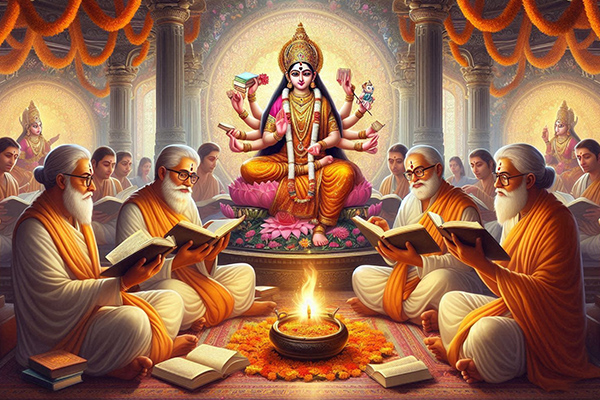
In the morning, after taking a bath and finishing one’s daily worship or other rituals, one should sit on an asana facing North or East and try to evoke a state of concentration and devotion.
The paath (reading) is most effective when done with firm faith, devotion and correct pronunciation. During the time of reading, one should try not to talk, sleep, sneeze, yawn or spit, but read with complete concentration on Devi in the form which appeals to one. One should not stop in the middle of a chapter. It is good to place the book on a stand, preferably a copper plate.
At the beginning and end of each chapter, bells may be rung.
Before starting the paath, affirm the purpose for which you are performing it – make a resolve, sankalpa, and perform worship of Devi.
Navaratri is an ideal period for the paath of Durga Saptashati; however, in the other months, Tuesday, Friday and Saturday are considered auspicious days of the week for beginning the reading. The ideal days of the lunar calendar are ashtami (eighth day of the moon), Navami (ninth day of the moon) and Chaturdashi (fourteenth day of the moon).
This is the traditional rule. It is believed that whatever sankalpa the Saptashati is read with, will be fulfilled. Since Shakti is the basis for all iccha (desire), jnana (knowledge) and kriya (action), one cannot stay out of the realm of Shakti. An individual is but Shakti, and hence one can have everything through the worship of Shakti. The reading should be in the following order:
- Devi Suktam
- Devi Kavacham
- Argala Stotram
- Keelakam
- Ratri Suktam
- Devi Mahatmya
- Kshama Prarthana
Here is a summary of each of the 13 chapters (Adhyayas) of the Durga Saptashati:
Chapter 1: Madhu-Kaitabha Vadh
In the first chapter, the sage Medhas narrates to King Suratha and the merchant Samadhi the story of how the supreme Goddess, in her form as Mahakali, emerged from Vishnu's body and annihilated the demons Madhu and Kaitabha. The two demons had sprung from Vishnu's ears while he was in deep slumber. Mahakali battled the demons fiercely and ultimately slew them, thus restoring balance and peace.
The first chapter is to be read on day 1 of Navratri.
Chapter 2: Mahishasura Mardini
This chapter describes the emergence of Goddess Mahalakshmi from the combined energies of the Trinity (Brahma, Vishnu, and Shiva) and the other gods to vanquish the demon Mahishasura. Armed with the weapons given by various deities, Mahalakshmi fought the demon and his formidable army. After a fierce battle, she destroyed Mahishasura, who had become a buffalo, earning the title of Mahishasura Mardini.
Chapter 3: The Slaying of Dhumralochana
In this chapter, the demon Dhumralochana is sent by Shumbha and Nishumbha to capture Goddess Durga. With a mere sound of her 'hum' chant, Durga reduces Dhumralochana to ashes. His army is also decimated effortlessly by her lion. This chapter highlights the invincible power and fearsome aspect of the Goddess.
Read Chapter 2 & 3 on the 2nd day of Navratri.
Chapter 4: The Slaying of Chanda and Munda

The fourth chapter narrates the story of how Goddess Chamunda (an aspect of Durga) was created from the forehead of Goddess Durga to kill the demons Chanda and Munda. Chamunda engages in a fierce battle with the demons and finally beheads them, presenting their heads to Goddess Durga. This act further enrages the demon kings Shumbha and Nishumbha. Read this chapter on the 3rd day.
Chapter 5: The Slaying of Raktabija
This chapter details the battle between Goddess Kali (another form of Durga) and the demon Raktabija. Raktabija had a boon that every drop of his blood that fell to the ground would spawn another demon like him. Kali, with her immense power, prevents his blood from falling to the ground by drinking it, thus defeating Raktabija.
Chapter 6: The Slaying of Nishumbha
Here, the battle continues as Nishumbha, the brother of Shumbha, confronts Goddess Durga. Durga's fierce combat skills are described in vivid detail as she slays Nishumbha and his formidable army, demonstrating her unstoppable might and divine authority.
Chapter 7: The Slaying of Shumbha
In this climactic chapter, Shumbha confronts Durga. After a ferocious battle where Shumbha accuses Durga of relying on the powers of her various manifestations, she absorbs all her forms back into herself and slays Shumbha single-handedly. This chapter emphasizes the unity and supreme power of the Goddess.
Chapter 8: Praise of the Goddess by the Gods
The eighth chapter is a hymn of praise offered to the Goddess by the assembled gods, who extol her virtues, her benevolence, and her fierce protectiveness. They thank her for saving the universe from the demons and ask for her continued blessings and protection.
Read Chapter 4-8 on day 4th of Navratri.
Chapter 9: The Boons Granted to Suratha and Samadhi
In this chapter, King Suratha and the merchant Samadhi, who had listened to the stories and praises of the Goddess, perform intense penance to invoke her blessings. Pleased with their devotion, the Goddess appears before them and grants their wishes—Suratha regains his lost kingdom, and Samadhi attains spiritual knowledge and liberation.
Chapter 10: The Goddess's Promise to Aid the Devotees
Here, the Goddess promises to appear in various forms to protect her devotees whenever they are in distress. She assures them that she will manifest to restore dharma and annihilate evil. This chapter highlights the merciful and protective nature of the Goddess towards her worshippers.
Read chapter 9 & 10 on 5th day of Navratri.
Chapter 11: The Goddess’s Glories
This chapter recounts the various incarnations of the Goddess and the demons she has slain in each form. The sages extol her for her past deeds and her omnipresence, reinforcing her role as the ultimate savior and protector of the universe.
Read this chapter on the 6th day.
Chapter 12: The Phala Shruti
The twelfth chapter describes the benefits of listening to or reciting the Durga Saptashati. It promises liberation from all sorrows, fulfillment of desires, protection from all forms of evil, and the attainment of spiritual and material prosperity for the devotees who engage in the recitation with faith and devotion.
Chapter 13: The Final Blessing
In the concluding chapter, the Goddess blesses her devotees and assures them that she will always be there to protect those who call upon her with sincere devotion. This chapter encapsulates the compassion, power, and omnipresence of the Goddess Durga, leaving the devotees with a sense of divine security and reassurance.
These summaries encapsulate the essence of each chapter, highlighting the divine power and benevolence of Goddess Durga as depicted in the Durga Saptashati.
Read the 12th & 13th chapters on 7th day of Navratri.
Navratri Associated Products & Services
9 Mukhi Rudraksha
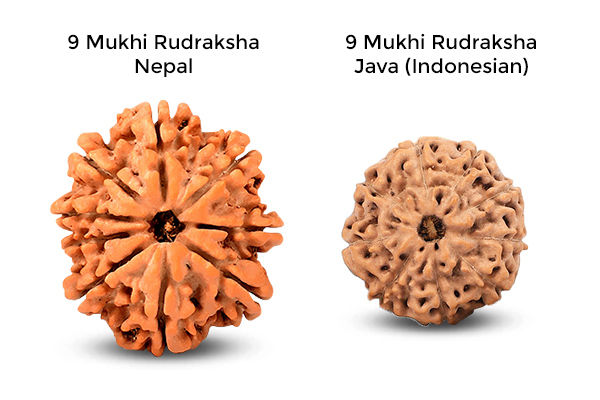
The 9 Mukhi Rudraksha is ruled by the divine Mother. Goddess Durga rules the rare nine Mukhi Rudraksha bead which hold the powers of all nine goddesses known as Nava Durga. The 9 Mukhi Rudraksha offers worldly comforts and fulfils desires known as Bhogha and offers liberation meaning Moksha to the wearer. Buy 9 Mukhi Rudraksha to receive the divine power of Shakti this Navratri.
Gomed Stone

Buy Gomed Stone on the holy festival of Navratri
Hessonites have been prized as jewels for over 5000 years. Gomed stone or Hessonite is a gemstone known for its sparkling brown and reddish tones and use in beautiful jewelry. It is a powerful stone that bestows power, renown, political and social success, protection, and financial wealth. It is also well-known for destroying hidden foes and unseen negative energy in the environment.
Durga Puja

Powerful Goddess Durga Pujas conducted by our team of qualified Pandits complete with all Vedic rituals to revere Divine Mother Goddess and seek blessings of Protection, Power, Courage, Good Health, Prosperity, Wisdom, Spiritual Augmentation, relief from malefic effects of Planet Rahu, fulfillment of material and other desires. Book the Puja to receive blessings of Maa Durga in Navratri.
Durga Yantra
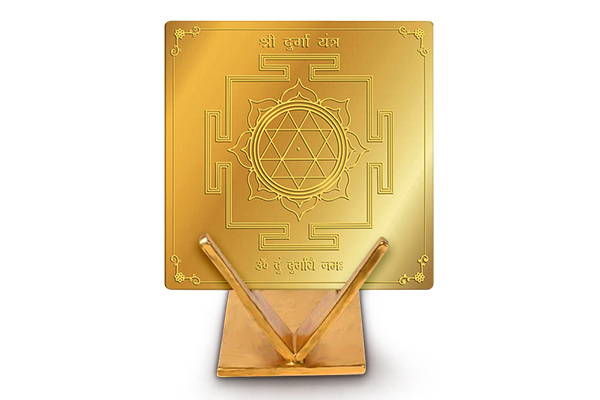
Durga Yantra bestows wealth and property and protects the person from all sorts of dangers. According to Adhayaya 4 Sloka 17 of Durga Saptashati (most powerful and potent collection of mantras dedicated to Goddess Durga created from Markandeya Puran), worshipping of this Yantra helps remove poverty. Receive strength and power, triumph over obstacles, and total supremacy over one's enemies during Navratri.
Durga Idols
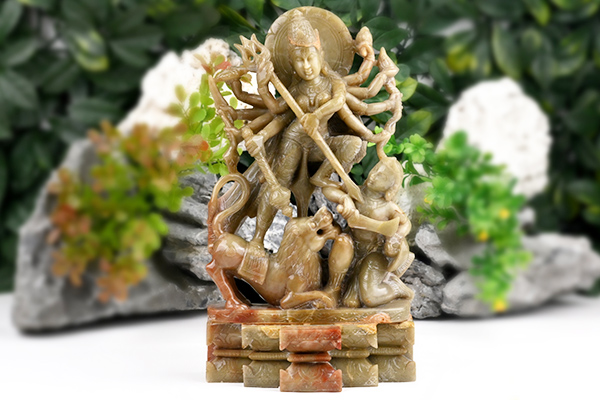
Goddess Durga represents power, victory, determination, energy and positive energies that destroys and protects from all negative energies. Keeping Durga idol/s at home or workplace during Navratri brings an abundance of divine power and blessings.
Kanya Pujan
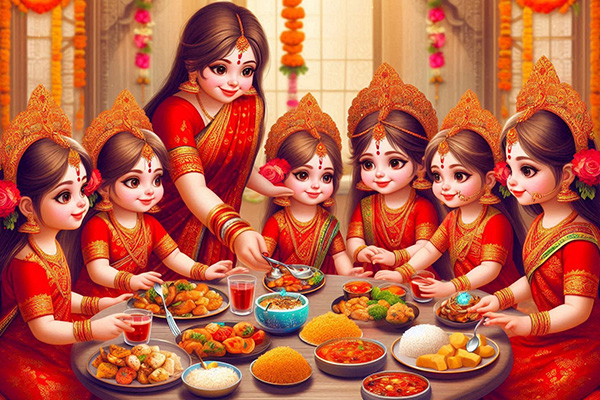
Kanya Pujan is observed on the eighth or ninth day of Navratri, known as 'Ashtami' or 'Navami,' and it involves the worship of young girls as forms of Goddess Durga. Book kanya Pujan on the auspicious day of Ashtami or Maha Navami of Navratri.


-in-Astrology.jpg)
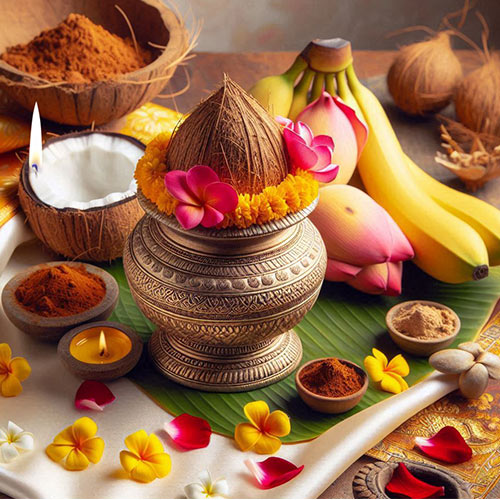
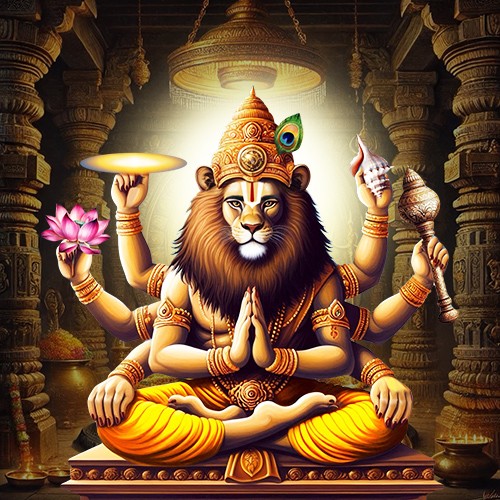
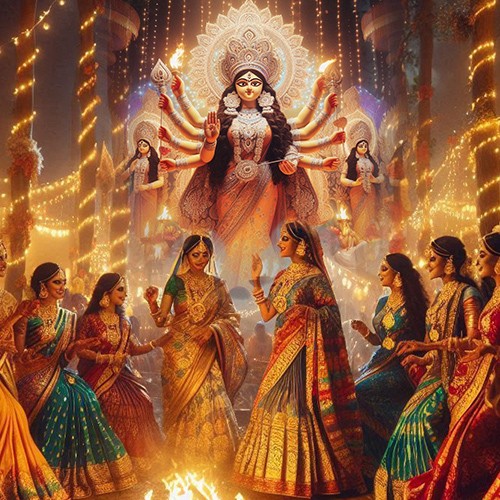
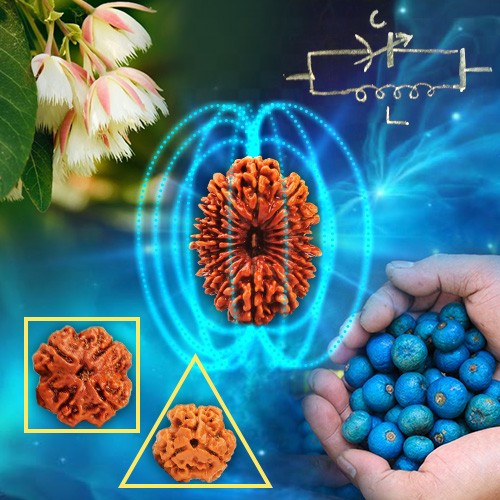


.jpg)
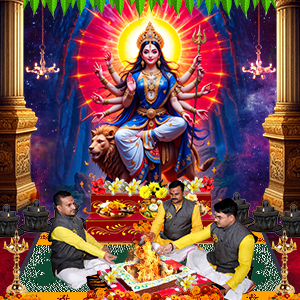

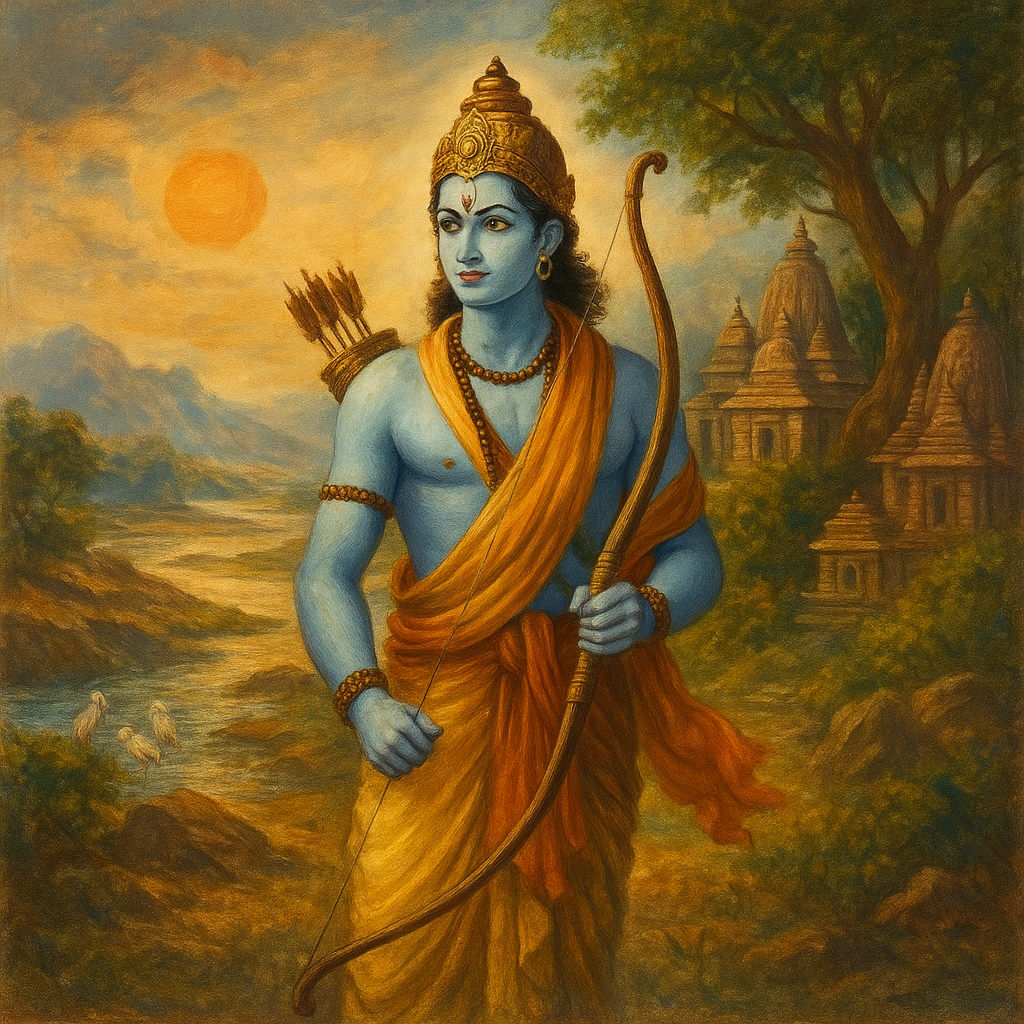
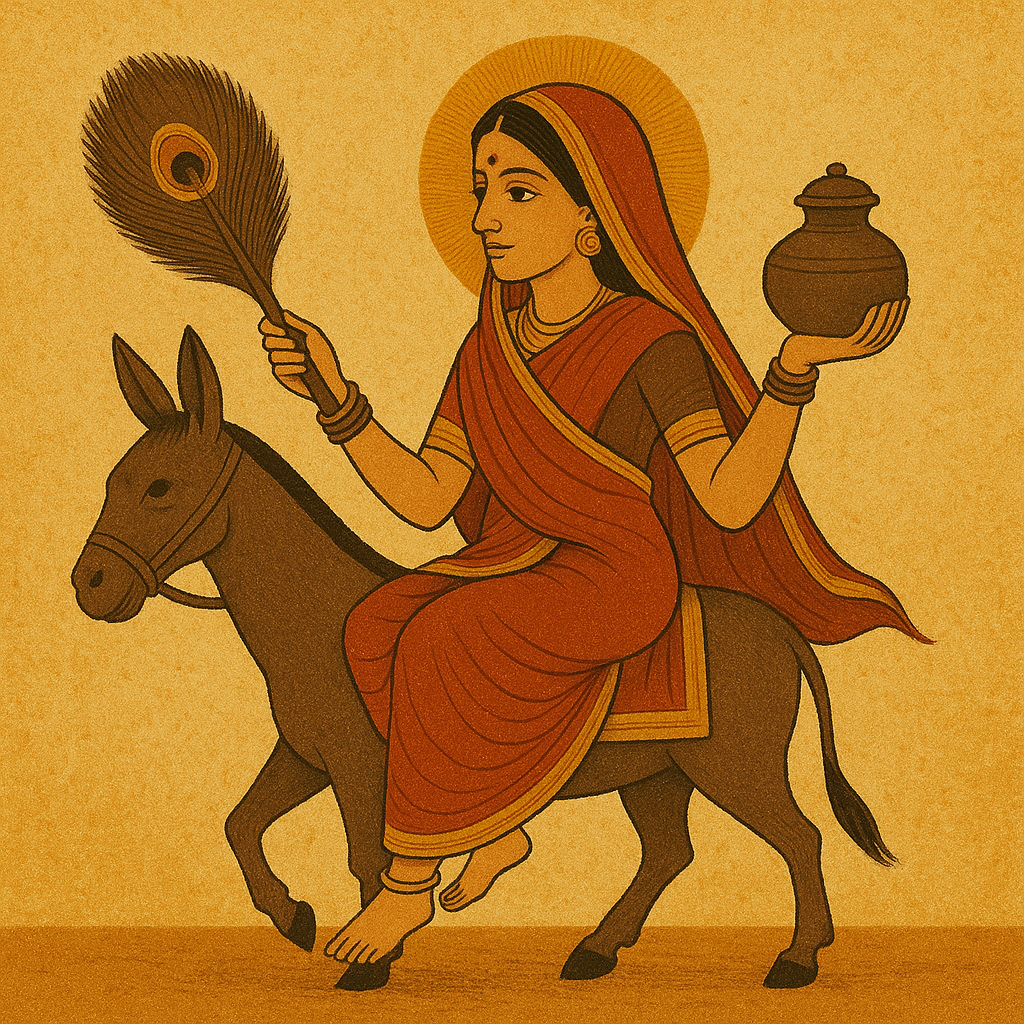
Priti Mehta
|September 15, 2025
Kindly acknowledge me with all 4 Navratris as your website is knowledgeable about all the festivals.